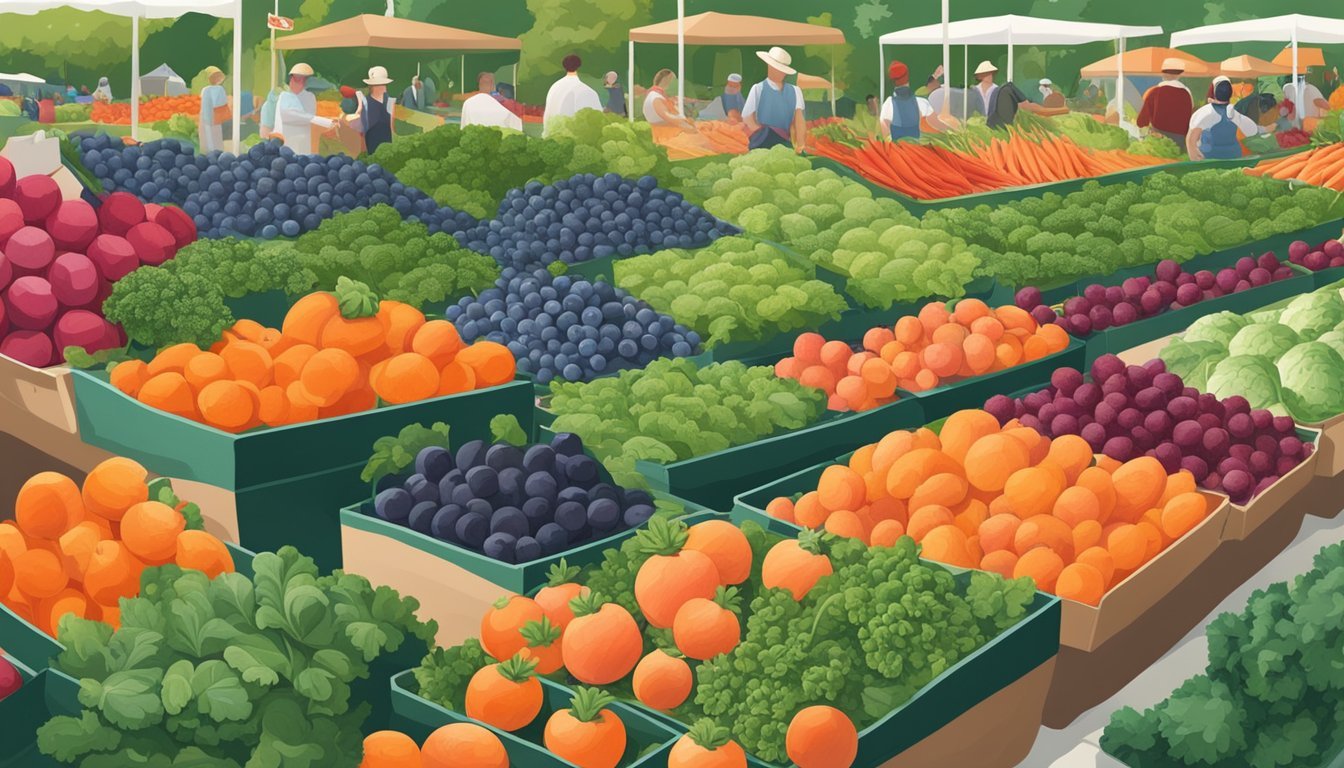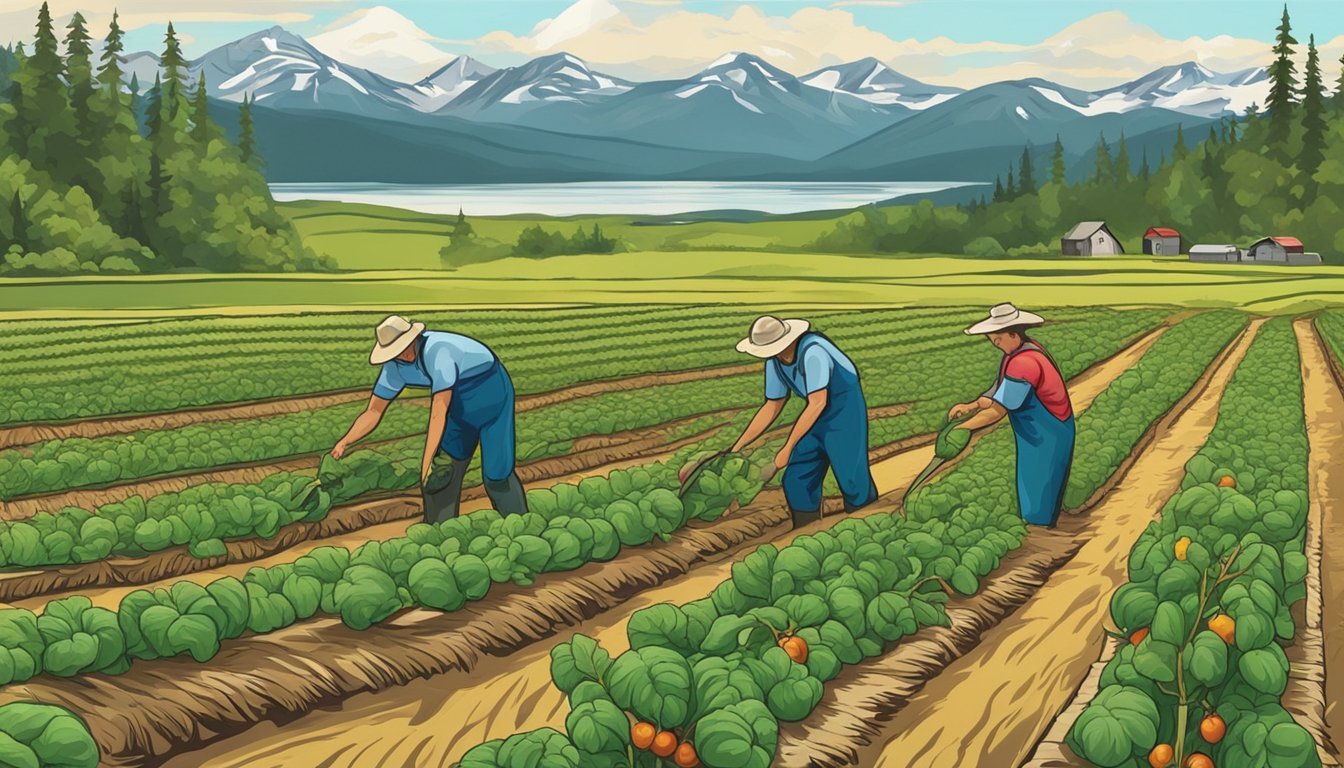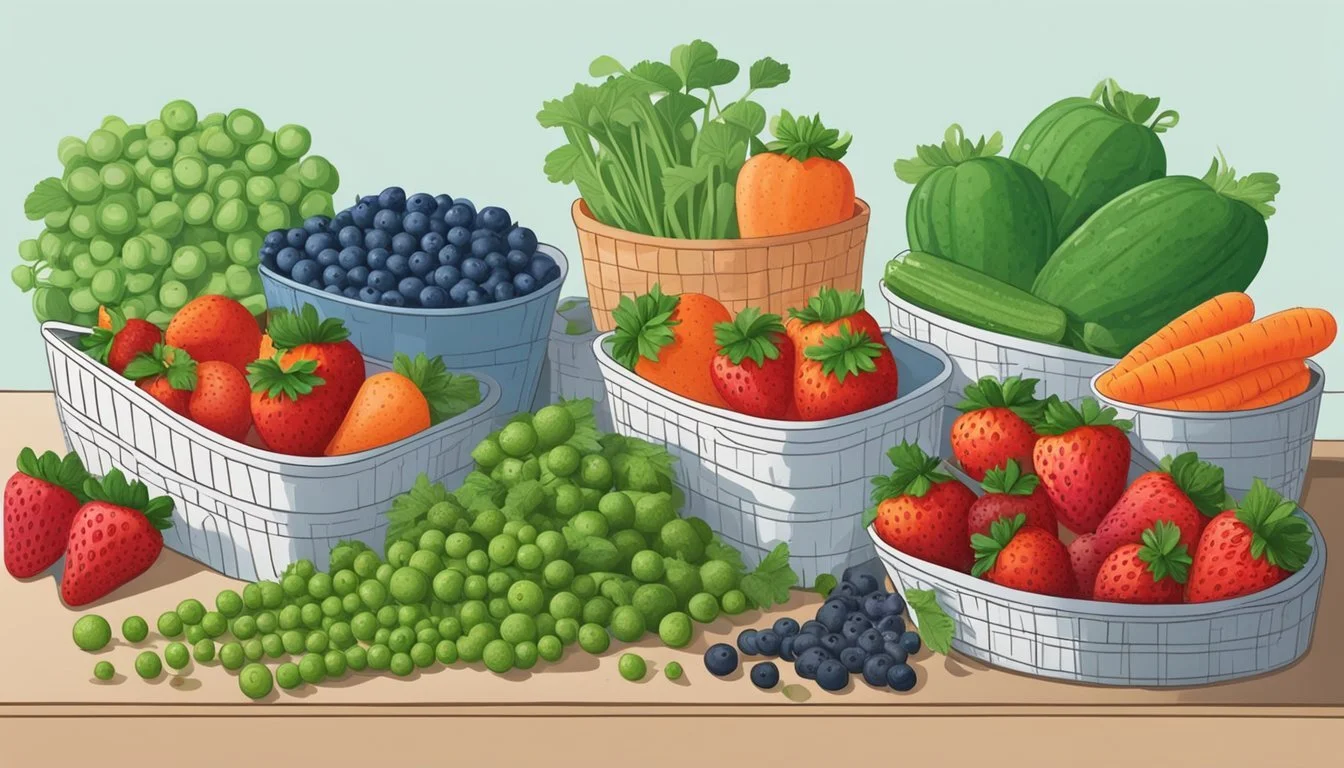Alaska Seasonal Fruit & Vegetables in July
Your Guide to Fresh Picks
This Article is Part of our Alaska Seasonal Fruit & Veg Calendar
July marks the height of summer in Alaska, a time when the long days and mild temperatures create the perfect setting for a diverse array of fruits and vegetables to thrive. The state's unique growing conditions, characterized by extended daylight hours, allow for a brief but bountiful harvest season. Gardens, farms, and local markets brim with fresh produce, offering a testament to the resilience and richness of Alaskan agriculture.
During this month, consumers can expect to find a variety of leafy greens such as kale and lettuce, which are known for their crisp texture and vibrant hues. Root vegetables like carrots and beets (how long do beets last?) also come into season, their earthy flavors reflecting the fertile soils in which they are grown. Berries, a highlight of Alaskan produce, begin to reach their peak, with blueberries and strawberries offering sweet, tart bursts of flavor that encapsulate the essence of summer in the region.
Alaska's July produce selection extends to vegetables like broccoli, cabbage, and peas, all freshly harvested and packed with nutrients. The relatively cool climate of the state, even in summer, yields produce with a freshness and quality that stands out in flavor profiles. As a result, Alaska's July bounty is eagerly anticipated by chefs and consumers alike who seek out seasonal freshness for their culinary creations.
Overview of Alaska's Growing Seasons
Alaska's growing seasons are determined by its unique climate and extended daylight hours during the summer months. These factors are pivotal in shaping the growth and harvest periods for local fruits and vegetables.
Understanding Alaska's Unique Climate
Alaska's climate varies widely, ranging from the rainforests of the Southeast to the arctic zones of the North. The growing season is relatively short, with most farming activities occurring between the end of May and the beginning of October. Summer conditions can be mild and conducive to agriculture, especially in the southern regions. Farmers contend with diverse challenges including temperature fluctuations and soil conditions that can affect the viability and variety of produce grown across the state.
The Impact of Daylight Hours on Growth
In Alaska during June and late into the summer, plants experience up to 19 hours of daylight, leading to a unique phenomenon known as the "midnight sun." This extended exposure to sunlight accelerates the growth of certain crops, allowing them to reach maturity more quickly than they would in a more temperate climate. While July is peak season for many crops, as the season transitions towards late summer and into fall, the focus shifts to hardy vegetables such as winter squash. By October, the shorter days signal the end of the growing season for most outdoor agriculture in Alaska.
Seasonal Availability
In July, Alaska's agricultural offerings reach their peak of variety. Local markets brim with an array of fresh produce that is both rich in flavor and nutrition.
What's In Season in July?
Vegetables:
Beans
Beets
Cabbage
Fruit: Typically, July is not a peak month for fruit harvests in Alaska due to the climate. However, some hardy varieties may still be available from greenhouse growers or from the previous season's storage.
Featured Alaska Produce in July
July in Alaska is a prime time for harvesting a variety of fresh, ripe produce. The long days and unique climate conditions contribute to the growth of flavorful fruits and nutritious vegetables during this month.
Berries
Strawberries: The Alaskan strawberry season is brief but produces some of the most flavorful berries due to the extended daylight hours. These berries are typically ready for picking in early July.
Blueberries: They begin to ripen in July, offering a sweet and tangy flavor that is ideal for fresh eating, preserves, or baking.
Raspberries: These berries come into season in July and are known for their bright color and balance of sweet and tart.
Vegetables
Greens: A variety of greens become available in July, including:
Lettuce: Crisp and fresh, perfect for summer salads.
Kale: Hardy and nutrient-rich, kale thrives in Alaska's cooler temperatures.
Cabbage: Alaska's cabbages are known for their large size and sweetness, making them a staple in local summer harvests.
Harvesting and Selecting Quality Produce
When it comes to harvesting and selecting premium fruits and vegetables in Alaska during July, one must consider factors like size, color, and firmness to determine ripeness and quality.
Tips for Picking Fresh Produce
Size: The produce should be consistent with the typical size for the species; unusual size could indicate either premature picking or overripeness.
Berries: They should be full and round.
Root Vegetables: Carrots and beets should be firm to the touch.
Leafy Greens: Look for vibrant, unblemished leaves.
Feel: The texture of the produce can signal freshness.
Fruits should yield slightly to pressure but not be mushy.
Vegetables should be firm and heavy for their size.
Indicators of Ripeness
Color: A fruit or vegetable's color is often a reliable indicator of its readiness for consumption.
Bright hues typically suggest that the item is ripe.
Look for a uniform color free from dark spots or yellowing.
Plumpness: Plumpness can be a sign of produce that has reached its peak.
Berries and cherries should be plump and tight-skinned.
Leafy greens should look full and not wilted.
By considering these factors, shoppers can feel confident in their ability to select the best harvest.
Preserving the Harvest
July in Alaska sees an abundance of fresh produce that can be enjoyed throughout the year if preserved correctly. Preserving the harvest requires timely and proper methods to ensure the quality and safety of fruits and vegetables.
Food Preservation Techniques
Canning is a popular method for preserving fruits and vegetables. High-acid foods such as berries can be processed using a water bath canning method, while low-acid vegetables should be preserved using pressure canning for safety. Pickling is another technique that not only extends the shelf life of produce like cucumbers (how long do cucumbers last?) but also adds a unique flavor profile. Marketable items such as jams and jellies can be made from Alaskan berries and sealed for later consumption.
Drying fruits and vegetables is an energy-efficient preservation method, where items like peas can be dehydrated for long-term storage.
Freezing is a simple preservation method suitable for many types of produce, including berries, which can later be used in desserts or smoothies.
Storing for Freshness
Proper storage extends the longevity of Alaska's fresh produce. A cool, dry place is ideal for storing onions and potatoes, while other vegetables like lettuce and green onions/scallions should be kept in the fridge to maintain freshness.
Vegetables such as carrots and beets can be kept in the fridge in moisture-proof bags to retain their crispness.
To enjoy baked goods later, baked items containing seasonal fruits can be tightly wrapped and frozen.
By using these preservation techniques, Alaskans ensure their July harvest continues to provide nourishment and enjoyment well into the winter months.
Garden to Table
July in Alaska presents a unique opportunity for gardeners and cooks to enjoy a bountiful harvest of fresh produce. From the crisp texture of radishes to the sweet burst of raspberries, the month overflows with ingredients perfect for home cooking.
Simple Recipes Featuring July Produce
Alaskans take advantage of the fleeting summer abundance by incorporating fresh July produce into simple yet flavorful recipes. Salads and side dishes are particularly common, as they allow the natural tastes of the vegetables and fruits to shine through.
Radish and Cucumber Salad: Thinly sliced radishes and cucumbers deliver a cool and refreshing crunch, seasoned with a mild vinaigrette.
Sautéed Greens: Turn kale or swiss chard into a divine side by sautéing with garlic in olive oil.
For those with a sweet tooth, raspberries from the local gardens make excellent additions to baking recipes. Homemade raspberry jam, folded into scones or layered between shortcakes, exemplifies pure summer flavors.
Alaskan-Inspired Dishes
The traditional Alaskan kitchen transforms July's harvest into hearty meals, reflecting a fusion of local and seasonal ingredients.
Potato Leek Soup: A creamy, comforting blend heightened by the fresh taste of July potatoes and the subtle bite of leeks.
Baked Rhubarb: Often turned into a lightly sweetened dessert or tangy compote, pairing exquisitely with meats or as a dessert ingredient.
Each dish represents the state's utilitarian yet delicious approach to cooking — emphasizing preservation of the summer's yield while enjoying the freshness of now.
Community Involvement
Alaska's communities actively engage in celebrating local produce during July with vibrant farmers markets and specialized agricultural events.
Farmers Markets and Festivals
Farmers Markets in Alaska provide a platform for local producers to showcase a variety of fresh, seasonal vegetables and fruits. In July, markets in Juneau and other regions are bustling with activity. These markets not only bolster the local economy but also become social hubs where Alaskans can directly support their local farmers. Information about market schedules and locations is often shared through social media platforms such as Facebook and Twitter, ensuring that community members are informed and engaged.
Festivals offer an enhanced market experience, with events often encompassing live music, workshops, and cooking demonstrations. July in Alaska is ripe for such festivals that celebrate the local bounty, welcoming residents and tourists alike to partake in the fresh flavors of the season.
Agricultural Events in Alaska
July is a significant month for agricultural events in Alaska, where enthusiasts gather to learn, exchange ideas, and celebrate farming achievements. These events showcase a range of Alaskan produce, offering opportunities for growers to discuss sustainable practices and innovative farming techniques. Whether in small towns like Nome or larger cities, these gatherings serve as educational platforms for sharing knowledge about Alaska's unique growing conditions and the hardiness of its local crops.
Challenges and Considerations
In the context of Alaskan seasonal fruits and vegetables, July presents unique challenges that impact cultivation. Farmers and gardeners must navigate specific issues that can affect the quality and yield of their produce.
Pests and Natural Challenges
Pests pose a significant threat to Alaskan produce, especially during the peak growing season. The cabbageworm and root maggots are particularly problematic for dark green leafy vegetables. Farmers must vigilantly monitor their crops and employ methods like:
Biological controls: Such as introducing beneficial insects that prey on harmful pests.
Physical barriers: Including row covers to protect plants from getting infested.
Growing in Containers and Small Spaces
Container gardening in Alaska can offer a solution to space limitations and soil challenges. It allows for better control over the growing environment and can mitigate some natural challenges. When growing dark green vegetables or other produce in containers, gardeners should:
Ensure proper drainage to prevent root rot.
Choose containers of adequate size to support the plant's growth.
Utilize high-quality potting mix enriched with nutrients.
Growing in small spaces requires strategic planning to maximize sunlight exposure and protect against fluctuations in temperature that can stress the plants.
Month-by-Month Guide
In Alaska, seasonal fruits and vegetables have a unique growing timeline due to the state’s specific climate conditions. This guide will focus on the availability of produce from the summer months into the early fall period, outlining what one can expect to find in July and the surrounding months.
Produce Guide for Surrounding Months
June:
The midsummer climate allows for a burst of fresh produce. Residents and visitors in Alaska can delight in the early harvests of:
Rhubarb
Greens such as kale and lettuces
A variety of herbs
July:
This is the peak month for Alaskan produce, where the extended daylight hours result in an abundant crop. The following are typically ready to be harvested:
Berries, including blueberries, strawberries, and raspberries
Zucchini and summer squash
Broad beans and peas
August:
As the summer begins to wind down, there is still a generous yield of fruits and vegetables, including:
Root vegetables like carrots and beets
More berries, with the addition of blackberries
Cauliflower and broccoli
September:
The onset of fall brings its own variety of produce that can withstand cooler temperatures, such as:
Potatoes
Cabbage
Harvest of late-season berries like lingonberries
October:
With the growing season coming to a close, hardier vegetables that can thrive in cooler weather become available. These include:
Winter squash
Pumpkins
Brussel sprouts
It's important for consumers to take advantage of this fresh and local produce while it lasts, as the range decreases significantly with the approach of winter.
Supporting Local Agriculture
In July, when Alaska's agricultural offerings are at their peak, the impact of supporting local growers goes beyond just enjoying fresh produce; it also sustains the local community and economy.
The Importance of Supporting Local Growers
Supporting Alaskan growers means providing direct aid to family farms and businesses within the state. When individuals purchase from local farmers, they help preserve agricultural traditions and foster biodiversity, as these growers often cultivate a variety of crops including cucumbers, greens, and lettuce that are in season in July. This practice enhances the resilience of the local food system against large-scale farming challenges.
Community Health and Economy
Community health benefits from the consumption of fresh, nutrient-rich foods that local Alaskan growers provide, which in July include items such as currants and green onions/scallions. These fresh goods contribute to a healthier community. Additionally, money spent within the community generates income for local growers, which then circulates through local markets and strengthens the state's economy. The direct relationship between grower and consumer at markets and through community-supported agriculture (CSA) programs enhances transparency and trust in food quality.
By actively choosing to support local agriculture, individuals contribute significantly to the vitality and sustainability of Alaska's agricultural landscape.










